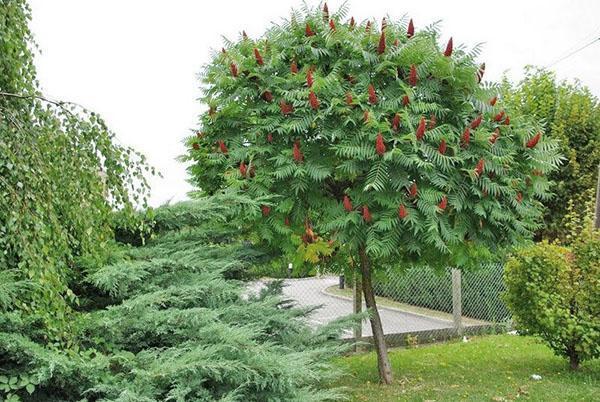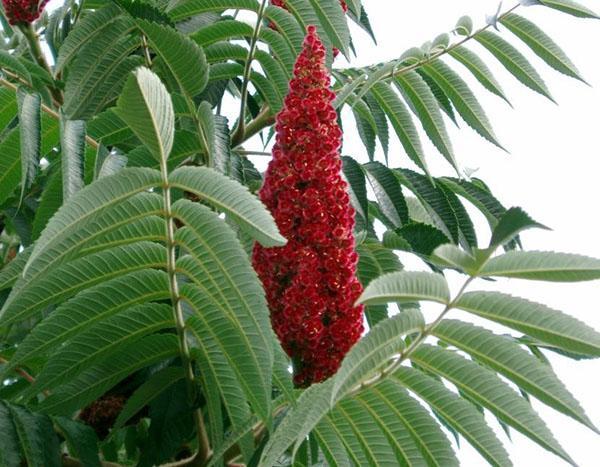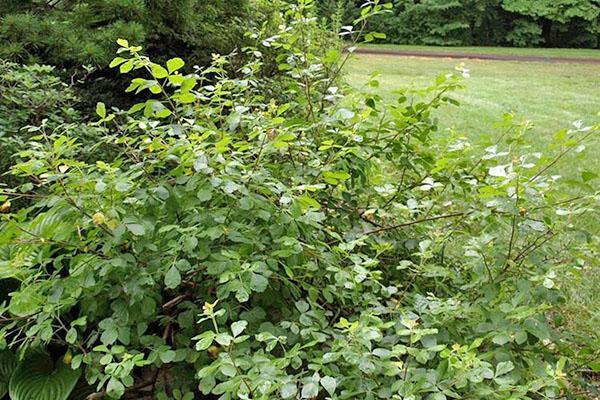Unusual sumac tree at their summer cottage
 The sumac tree, planting and caring for which is not difficult, is in demand in many countries of the world. It is a pleasure to grow such a plant in your area. Observing generally accepted rules, you can get an unusually beautiful tree in a fairly short time, which is one of the most ancient plants on our planet.
The sumac tree, planting and caring for which is not difficult, is in demand in many countries of the world. It is a pleasure to grow such a plant in your area. Observing generally accepted rules, you can get an unusually beautiful tree in a fairly short time, which is one of the most ancient plants on our planet.
Sumac tree: features and types of plants

With proper care, the vinegar tree can grow for 20 years.
Plant species:
- Sumac is fragrant. It is presented in the form of a creeping bush. Sumac grows fragrant up to 1 m in height, some twigs can reach 3 m. It grows very slowly, but always has a beautiful appearance. The first flowering can be observed only 5 years after planting. At the end of June, pyramids appear on the branches, which have a white tint.

- Sumakh is naked. It is distinguished by a bushy tree and large variegated leaves, the shares of which reach 12 cm in length. The entire plate grows up to 50 cm. In the summer, they have a rich green hue, but with the onset of autumn they turn orange. Sumac grows up to 3 m tall. The crown is umbrella-shaped. The twigs are bare. Flowers appear on them in the form of panicles of white and red hues. They grow about 20 cm long. At the end of flowering, round fruits are formed, which are slightly flattened and pubescent. They are on the tree throughout the winter.

- Sumac is fluffy. In our latitudes, this species is called the vinegar tree. The plant is distinguished by variegated foliage and a colorful crown. In the wild, it grows up to 10 m, but in the area its height rarely exceeds 5 m. Young specimens are straight with a few twigs. Adults become sprawling and quite lush. The branches of the vinegar tree are light, thick. The leaves combine several lobes, each of which reaches 12 cm. This species also blooms in June. The inflorescences are large and colorful. They have a red tint.

Sumac fluffy comes in several varieties. They differ in the shape of the crown and the color of the deciduous plates.
Sumac tree: planting and care
 Sumach cultivation is a simple procedure. Even a novice gardener can cope with such a task. Observing all the recommendations, you can grow a beautiful ornamental tree without any effort.
Sumach cultivation is a simple procedure. Even a novice gardener can cope with such a task. Observing all the recommendations, you can grow a beautiful ornamental tree without any effort.
If the seedling is not even, then it was cut.
Sapling selection
 When buying planting material, you need to pay attention to the crown and twigs. The tree should be symmetrical, and the leaves should be even, without any defects.
When buying planting material, you need to pay attention to the crown and twigs. The tree should be symmetrical, and the leaves should be even, without any defects.
It is necessary to pay attention to the condition of the root system. You should buy those specimens whose roots are even and well developed. It is not recommended to buy plants with damaged lobes. Often such specimens do not take root.
Seat selection
 It is necessary to plant a tree in those areas that are well lit by the sun. Sumac can grow in the shade, but in this case the leaves and inflorescences will not be so colorful.
It is necessary to plant a tree in those areas that are well lit by the sun. Sumac can grow in the shade, but in this case the leaves and inflorescences will not be so colorful.
You should not place the plant between other trees, even if they are undersized. This can negatively affect its development.
It should also be noted that sumac does not like strong winds.Therefore, the site where it is planned to plant must be well protected from drafts.
Sumach soil
 The vinegar tree develops best on loose and fairly dry soils. You can plant seedlings in sandy, sandy-clayey and sandy-rocky soils.
The vinegar tree develops best on loose and fairly dry soils. You can plant seedlings in sandy, sandy-clayey and sandy-rocky soils.
Sumac does not tolerate much moisture. Therefore, if groundwater is close to the selected site, then it is better to abandon the idea of planting it there. All exactly the tree will not be as beautiful as it should be.
Sumac feels good in soils with average salinity. It also develops well in areas with limestone.
How to plant seedlings correctly
 Planting is carried out in a vein or in the fall. Saplings must be at least 2 years old. To begin with, prepare a dimple. Its dimensions should be the same as an earthen ball around the root system.
Planting is carried out in a vein or in the fall. Saplings must be at least 2 years old. To begin with, prepare a dimple. Its dimensions should be the same as an earthen ball around the root system.
Mix the soil from the dimple with a shovel compost... This is necessary in order for the young plant to take root well and quickly.
Place the seedling in a dimple. Spread the roots well around the entire perimeter of the recess. Then cover the empty space with prepared soil.
If several trees are planned to be planted on one site at once, then it should be remembered that the distance between the specimens must be at least 2.5 m.
Proper care of an ornamental tree
 In order for the vinegar tree to always be beautiful and healthy, you must adhere to simple rules. Only in this way it will be possible to observe the beauty of inflorescences and leaves for 20 years.
In order for the vinegar tree to always be beautiful and healthy, you must adhere to simple rules. Only in this way it will be possible to observe the beauty of inflorescences and leaves for 20 years.
Irrigation and fertilization
Care should begin immediately after planting. The first thing to do is mulch the soil around the trunk. To do this, use sawdust or small wood chips. The mulch layer should be within 6 cm.
Young trees are irrigated only on dry days. To do this, use water that has stood in direct sunlight for at least two hours.
Sumac is fertilized in spring. To do this, use a nitroammophoska. 1 m2 add about 30 g of fertilizer.
Sumac pruning
 Since the plant does not tolerate frost poorly, after winter many branches dry out. Therefore, in the spring, the first thing to do is to remove all dead shoots. It is recommended to use sharp garden shears for the procedure, or secateurs.
Since the plant does not tolerate frost poorly, after winter many branches dry out. Therefore, in the spring, the first thing to do is to remove all dead shoots. It is recommended to use sharp garden shears for the procedure, or secateurs.
During the removal of branches, a yellowish sap forms at the site of the cuts, which hardens after some time.
For those who want the tree to grow wide, and not upward, the upper shoots should be removed. So the sumac will look much more attractive and interesting.
Potential diseases and pests
 Most often, fungal diseases can be observed on the vinegar tree. The most dangerous is powdery mildew.
Most often, fungal diseases can be observed on the vinegar tree. The most dangerous is powdery mildew.
You can identify this disease by the white spider web that abundantly covers the leaves. A few days later, a light bloom appears in its place. If nothing is done, the sumac may die.
Powdery mildew is caused by too hot or humid weather. Excess nitrogen can also lead to white bloom.
To prevent the tree from getting sick with this disease, it is necessary to systematically remove weeds around the trunk, as well as periodically loosen the soil. But if, nevertheless, the plant began to infect powdery mildew, then you will need to treat it with a special agent that can be purchased at a flower shop.
Sumac is not only a very beautiful but also incredibly useful plant. The vinegar tree has been used in folk medicine for many years. Thanks to the unique properties that it possesses, many different diseases can be cured.